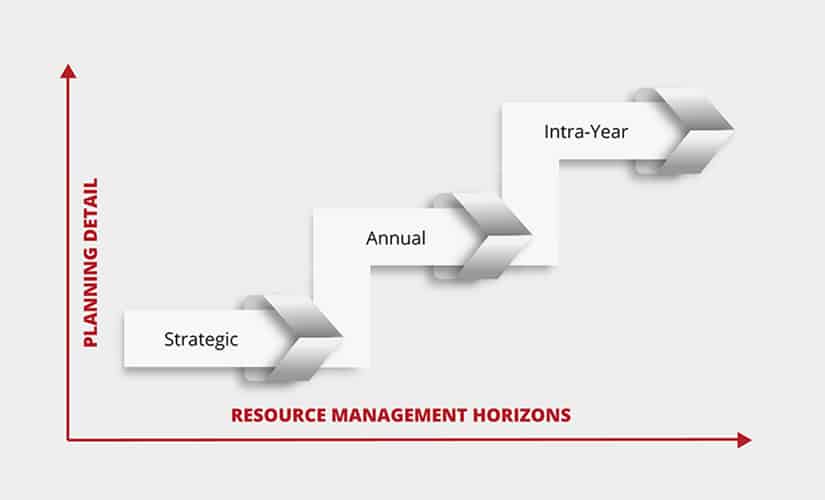Table of Contents
Corporate IT provides services in an environment characterized by high volatility and uncertainty. This is especially true in the context of a digital transformation, where IT must balance efficiency and agile innovation, and must manage resources flexibly to react to market disruptions or internal re-prioritization. To avoid inefficiencies caused by high coordination costs, it is important to know what level of detail is appropriate in what context and at what time.
This article provides a guideline for efficient and precise resource planning over the course of three different planning horizons – from strategic resource management down to intra-year planning and steering.
Planning Horizons and Level of Detail
Effective resource management is closely linked to planning efficiency. A frequent assumption is that early planning at a high level of detail can avoid coordination costs later on – after all, if everything has been planned out, an efficient and smooth process can be guaranteed, right? This assumption would be true if the environment and related requirements did not change. However, in a constantly changing environment, often no stone is left unturned. In order to avoid unnecessary efforts, detailed planning at an early stage should be avoided.
Therefore, we define three levels of abstraction in resource management, which increase in detail over time. We distinguish between strategic, annual and intra-year planning. Over the course of the three horizons, the level of planning detail increases as defining detailed realistic plans becomes more reasonable.
The Strategic Planning Horizon in Resource Management
The strategic planning horizon considers a period of three to five years. By considering this period, an awareness of possible resource-related risks must be identified. This enables to examine whether it is fundamentally possible to implement long-term planned initiatives and develop capabilities based on the available resources. Will the growing demand for innovation-oriented topics cause a need for skills that we do not sufficiently have? To what extent should the organization built up internal resources or rely on external capacities? Is it possible to cover our planned projects with the existing capacity, or are there even surplus capacities?
Long-term planning is also a good opportunity to link and reconcile the use of resources with the expected business outcomes. For most IT delivery items, this can be done at a high level for both operational services and future ‘build’ and ‘change’ issues.
The long-term planning takes place on an annual basis and is focused exclusively on high-level issues such as global organizational development. In this setting, strategies for the company’s locations are discussed and defined. For instance, location responsibles conclude that certain positions should no longer be staffed. As an alternative, the responsibles coordinate to staff the positions at alternative company locations around the world to increase costefficiency while maintaining equivalent outcome quality. This re-location of capacities frees up budget which then can be used to staff urgently needed experts.
Using Target FTEs facilitate long-term planning. Target FTEs can be used to identify how the resource management of locations should adapt in the next three to five years regarding staffing levels and corporate goals. Target FTEs further enable benchmarking of resource usage and enable resource responsibles to identify how certain savings impact an expected business outcome in the event of short-term cost pressure. Instead of lapsing into actionism, we can proceed strategically.
However, detailed planning is not part of long-term planning. Since too-early detailed planning will most likely be subject to numerous changes in the future, it is not possible to make any reliable statements based within the strategic planning horizon. The implied false security of a detailed plan at this point would lead to unnecessary reconciliation efforts between involved stakeholders.
Specification in the Annual Planning
When it comes to annual planning, current and new topics are evaluated in the light of strategy and expected business outcomes.
First, demand and supply capacities of the portfolio are matched on an annual basis. Portfolio issues found on this level must be considered and handled before continuing with planning. The following questions can be used to identify portfolio issues. Are there any portfolio items that will not be addressed due to limited resources? Is there a poor match with the expected long-term business outcome? Should all topics be implemented as planned or did priorities change since strategic planning? Should capacities be shifted to internally built up new capacities, or extend the pool of available capacities by external support?
Once these questions have been answered and decisions have been accordingly made, it is worth looking at key resources and possible resource conflicts. It must be clear that, the risk of a conflict can only be recognized and not be solved at this point. The key is to be aware of and prepared for the risk. This degree of „restraint“ initially seems counter-intuitive, but on closer inspection it turns out to be necessary; even if a clear resource conflict emerges in the annual planning, it is known from practice that this resource conflict rarely occurs during actual plan execution – experience shows that a considerable amount changes between annual planning and actual plan execution.
Providing specific solutions to potential problems is unnecessary at this stage. Attempts might be undertaken to resolve resource conflicts involving key resources at an early stage and might create space for new conflicts to emerge. In this case, significant energy and effort have been invested in false security and the organization is no longer prepared for the initially identified risk, since the conflict has supposedly already been resolved or shifted.
To guarantee effectiveness in planning, it is not necessary to specify everything in detail during annual planning. The focus is on identifying the risks on the way to achieve goals, in order to later mitigate or prevent the effects of risks from occurring due to preparations.
(see figure 1)

Intra-Year Sequencing and Steering
Short-term management, such as sequencing of topics and delivery items, is carried out within the intra-year time horizon. During the processing of ongoing topics, the organization reacts to short-term priority changes and, through the preparation of the annual planning, resolves resource conflicts accurately where they occur, if required. In addition, the degree to which a goal has been achieved can be regularly updated as the execution of work progresses. This leads to increasingly accurate cost and capacity estimates.
Using employees’ time reporting as a data source for work progress can help to identify whether resources have been used as expected and whether the anticipated benefit has been delivered. In addition, the employees’ self-planning enables to steer and adjust capacities with high precision within a 2-month timeframe.
It is proven practice that the upcoming two months are the ideal planning horizon for specific staff deployment and scoping of delivery items in order to assess the degree of target achievement and time reporting. The 2-month employee self-planning is then updated continuously for the next two months, based on the current situation. Anything beyond that is subject of too much uncertainty, therefore would unnecessarily increase rescheduling efforts, and would create a false sense of security in the delivery, which results in regular justification and avoidable transactions costs between the involved planning individuals.
Transparency: The Foundation for Effective Resource Management
The calibration of the right level of accuracy for a specific planning horizon requires comprehensive transparency. This transparency is particularly important during intra- year plan execution. Transparency in execution enables conclusions to be drawn about the progress of a project. These insights are relevant for the higher planning levels as they provide feedback for future planning iterations. Are projects implemented according to the plans made? Have.
resources appropriately been used? What conclusions will be drawn for future planning iterations on the strategic and annual levels? Answering these questions reveals both opportunities and risks, which can be addressed and considered at an early stage. While creating this transparency across all levels, it is important to make sure that information proliferation is avoided by disclosing only management-relevant data.
Transparency in execution also enables efficient intra- year coordination. Digitalization projects are complex endeavors. If employees in a digitalization initiative cannot see who is working on which topic and to what extent, then coordination and agreement usually take place via a central bottleneck, so that communication among colleagues is reduced. As a result, coordination needs are frequently not be met and achieving a common focus is impaired. In this case, transparency must be demanded from a central authority. This process is subject to quality fluctuations, and it will not achieve the same level of coordination as ad hoc communication in well-functioning teams.
Transparency and the Works Council
Transparency and works council policies might be conflicting. Transparency could be interpreted as performance monitoring. In reality, transparency enables to protect the employee’s interests as overloads and bottlenecks become visible, therefore, can be mitigated.
Transparency enables the management of bottlenecks and free capacities to avoid or effectively reduce load peaks. If bottlenecks and free capacities are known, redistribution is possible. Transparency thus not only creates the basis for effective resource management and efficient execution of projects, but also protects employees’ interests through improved balancing.
About the Authors

Carolina Brüwer
Jan Seckler


